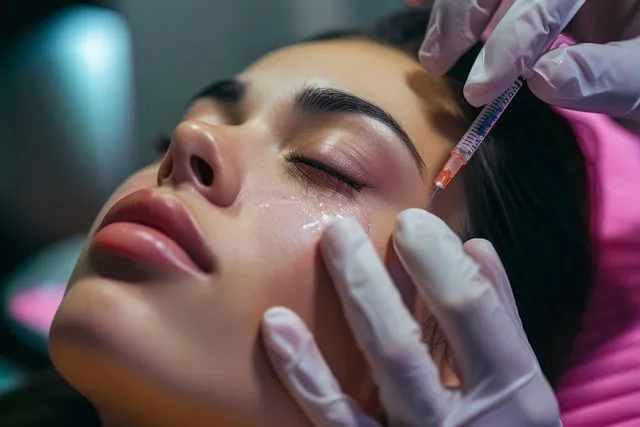Botox for facial contouring is a non-surgical procedure that relaxes jawline muscles, correcting imbalances and defining features. By targeting specific muscle groups, it reduces jowls, double chins, and saggy skin, achieving a more angular jawline without surgery or downtime. This method offers minimal invasiveness, remarkable outcomes, and natural-looking results, making it an appealing alternative to facial surgeries with fewer risks and a shorter recovery period. While common side effects include temporary swelling, bruising, or discomfort, rare issues like swallowing difficulties or asymmetrical jawlines may occur. Repeated treatments every 3-6 months are needed to maintain results.
“Discover the transformative power of Botox in achieving a tighter, more contoured jawline without surgery. This comprehensive guide explores the science behind muscle relaxation with Botox and its significant role in redefining facial aesthetics. From understanding the impact on jawline tightening to the step-by-step procedure, benefits, risks, and maintenance, we delve into the world of non-surgical Botox treatments for enhanced facial contouring. Enhance your beauty journey with this insightful exploration of Botox for facial contouring.”
Understanding Jawline Relaxation and Its Impact on Facial Contouring

The jawline is a significant feature that defines facial structure and contour. When it comes to facial aesthetics, relaxing the muscles around the jawline can have a profound impact on overall balance and symmetry. This is where Botox for facial contouring steps in as a non-surgical solution. By targeting specific muscle groups, particularly those responsible for jutting or squared jawlines, Botox can soften and refine these areas, leading to a more harmonious facial appearance.
Jawline relaxation techniques with Botox work by temporarily paralyzing or reducing the activity of facial muscles, allowing for a subtle yet noticeable change in facial contouring. This procedure is especially beneficial for individuals seeking to correct stubborn jawline fat, reduce the appearance of double chin, or achieve a more defined and angular jawline—all without invasive surgery.
The Science Behind Botox and Its Role in Muscle Relaxation

Botox, short for botulinum toxin, is a protein derived from a bacteria called Clostridium botulinum. It’s renowned for its ability to temporarily paralyze or relax muscles, making it a popular choice in facial contouring treatments, particularly for jawline tightening. When injected into specific muscles, Botox disrupts nerve signals that trigger muscle contraction, leading to relaxation and reduced wrinkling.
In the context of Botox for facial contouring, this science translates to a non-surgical procedure where tiny injections are made into targeted muscle groups around the jawline. This relaxes the muscles responsible for jutting or squaring jawlines, resulting in a smoother, more contoured appearance. The key lies in its temporary nature; as the effects wear off over time (typically 3-6 months), the treatment encourages the body to produce new collagen, enhancing long-term skin elasticity and maintaining the desired facial contour.
Benefits of Using Botox for Non-Surgical Jawline Tightening

Botox for facial contouring, particularly when applied to the jawline, offers a non-surgical solution for those seeking a more defined and sculpted look. This innovative approach to jawline tightening has gained significant popularity due to its minimal invasiveness and remarkable outcomes. One of the key advantages is the absence of recovery time associated with traditional surgical procedures, making it an appealing option for individuals who prefer a quick and effective method to enhance their facial features.
Additionally, Botox provides natural-looking results, allowing patients to achieve a more slender jawline without sacrificing their unique facial identity. By relaxing specific muscle groups, Botox can effectively reduce the appearance of jowls and saggy skin, providing a youthful and refined contour. This non-surgical technique is ideal for those who desire subtle improvements without the risks and downtime often associated with facial surgeries.
The Procedure: Step-by-Step Guide to Botox Injection for the Jawline

The procedure for Botox injection to tighten the jawline involves a precise and skilled approach. It begins with a detailed consultation where a qualified medical professional assesses your facial structure, skin condition, and specific goals for jawline contouring. After confirming suitability for the procedure, the area to be treated is cleaned and prepared. A fine needle is used to inject Botox into specific muscles along the jawline. These injections target dynamic lines and contours, relaxing the muscles responsible for excess jutting or squaring of the jaw. The process is typically quick, taking around 20-30 minutes, after which you can return to your daily activities with minimal downtime.
A step-by-step guide would involve:
1. Preparation: Cleansing and preparing the skin to minimize risk of infection.
2. Anesthesia: Applying a topical anesthetic to ensure patient comfort during injections.
3. Injection Sites: Identifying and marking key muscle groups along the jawline for targeted injection.
4. Botox Administration: Using a small needle to inject Botox into marked areas, relaxing the muscles over time.
5. Post-Procedure Care: Cleaning the treated area again and applying cold compresses to reduce any swelling or discomfort.
Potential Side Effects and Risks Associated with Jawline Botox Treatments

While botox for facial contouring, specifically targeting the jawline, is a popular non-surgical procedure, it’s crucial to be aware of potential side effects and risks. Temporary swelling, bruising, or discomfort at the injection sites are common. In rare cases, patients may experience difficulty swallowing, muscle weakness around the mouth, or an uneven jawline due to asymmetrical botox distribution. Allergic reactions, though uncommon, can also occur. Additionally, since botox is a temporary solution, repeated treatments every 3-6 months are necessary to maintain results, introducing ongoing costs and potential risks associated with multiple procedures over time.
Properly trained and experienced practitioners can minimize these risks, but it’s essential for individuals considering jawline botox treatments to have realistic expectations and discuss any concerns openly with their provider. They should also be aware that results may vary from person to person, and not everyone will achieve the desired jawline tightening effect.
Maintenance and Follow-Up Care After Botox for Facial Contouring

